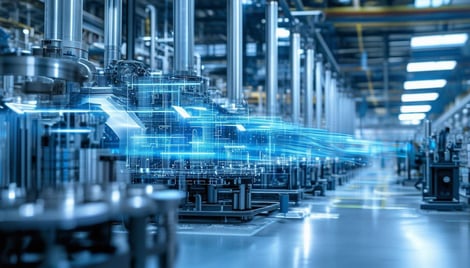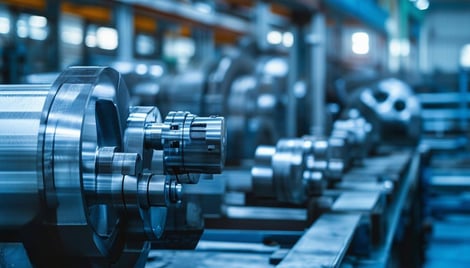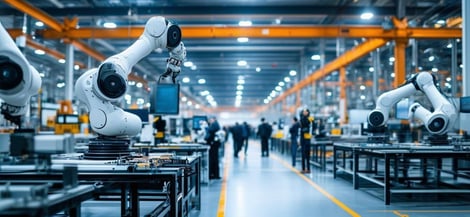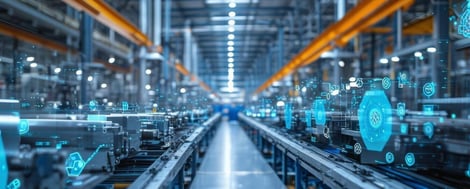Digital Twin Integration with PlanetTogether for Industrial Manufacturing Operations
Unlock efficiency in industrial manufacturing with Digital Twin integration with PlanetTogether. Real-time insights, predictive maintenance, dynamic...
Boost efficiency in industrial manufacturing with AI-powered resource allocation and PlanetTogether integration with top ERP systems like SAP and Oracle.

Optimizing resources has become more critical than ever in industrial manufacturing. Manufacturing IT Managers face the constant challenge of ensuring that every asset, whether it be labor, machines, materials, or energy, is utilized to its maximum potential. This is where Artificial Intelligence (AI) comes into play, offering a transformative approach to resource allocation. AI, combined with sophisticated planning and scheduling tools like PlanetTogether, can help manufacturers achieve better optimization, increase productivity, and reduce costs.
In this blog, we’ll explore how AI-driven resource allocation optimization works, how it can benefit industrial manufacturing facilities, and how the integration of PlanetTogether with systems like SAP, Oracle, Microsoft, Kinaxis, or Aveva enhances its effectiveness.

Resource allocation optimization refers to the process of assigning and utilizing resources in the most efficient manner possible. For industrial manufacturers, this means effectively managing resources such as raw materials, machinery, workforce, and production time. A failure to optimize resources can lead to delays, excess inventory, idle machines, and poor customer satisfaction—issues that significantly affect profitability and performance.
Historically, resource allocation decisions have been driven by manual planning processes, relying heavily on human intuition and experience. While effective in some cases, manual processes often result in suboptimal outcomes due to their complexity and the sheer number of variables at play. Moreover, relying on intuition alone can lead to mistakes, inefficiencies, and inconsistencies. This is where AI can make a significant difference.

AI and machine learning algorithms are capable of processing vast amounts of data in real-time, learning from it, and providing data-driven insights that humans might overlook. This is particularly valuable in the manufacturing industry, where the complexity of operations demands fast, accurate, and data-backed decisions.
Here’s how AI helps optimize resource allocation:
AI-powered systems can analyze historical production data, market trends, customer orders, and other relevant factors to predict future demand. This allows manufacturers to allocate resources—such as raw materials, machines, and labor—in anticipation of future requirements, reducing the risk of shortages or overproduction. By accurately predicting demand, manufacturers can improve their forecasting accuracy and ensure they are only using the resources they need.
AI-enabled software systems can continuously optimize production schedules based on real-time data. In traditional scheduling, planners might make adjustments based on their judgment or historical performance. However, AI systems analyze all variables, such as production bottlenecks, equipment maintenance schedules, and workforce availability, to adjust plans dynamically. This leads to more efficient use of resources and reduced downtime.
AI can also automate the allocation of resources based on priority orders, machine capabilities, workforce skills, and material availability. It can calculate the best combination of resources to maximize throughput and minimize delays, ensuring that operations are always running at peak efficiency.
AI systems monitor the performance of machines, labor, and materials, identifying underutilized resources. For instance, if a particular machine is running below its capacity, AI can automatically adjust the production schedule to ensure that the machine is used optimally. Similarly, workforce allocation can be adjusted to match skillsets with the specific tasks at hand, ensuring that employees are working on tasks that best match their skills, thus boosting productivity.
One of the biggest challenges in industrial manufacturing is unplanned machine downtime due to equipment failure. AI-driven predictive maintenance models can forecast when a machine is likely to fail based on historical data and sensor readings. This allows manufacturers to perform maintenance only when necessary, reducing the time and cost associated with unplanned maintenance while also ensuring that resources are used optimally.
AI algorithms can process real-time data from the shop floor, production schedules, inventory levels, and supply chains, adjusting operations as conditions change. For example, if there is a sudden shortage of a key raw material or a machine breaks down unexpectedly, AI systems can quickly optimize resource allocation to minimize the disruption. This agility is essential in today’s fast-moving industrial environments, where even small inefficiencies can lead to significant losses.

PlanetTogether is a leading advanced planning and scheduling software that provides real-time visibility into manufacturing operations. By integrating PlanetTogether with enterprise resource planning (ERP) systems such as SAP, Oracle, Microsoft, Kinaxis, or Aveva, manufacturers can leverage the full power of AI in resource allocation optimization.
Let’s explore how integration with these systems works and how it enhances resource allocation:
SAP is a comprehensive ERP system used by many industrial manufacturers to manage everything from supply chain management to production planning. Integrating PlanetTogether with SAP allows manufacturers to synchronize production schedules with supply chain and inventory data, providing a unified view of resources across the entire production process. AI-driven planning tools in PlanetTogether can work seamlessly with SAP’s data to ensure that all resources—material, labor, and machine capacity—are allocated efficiently. The system can then adjust production schedules in real-time based on changes in demand, raw material availability, or workforce capacity.
Oracle provides cloud-based enterprise solutions that help manufacturers manage finances, procurement, supply chain, and manufacturing operations. By integrating PlanetTogether with Oracle, manufacturers can gain real-time insight into their resource availability and optimize scheduling. AI models can predict when machines need to be serviced or when inventory is running low, helping manufacturing IT managers make informed decisions about resource allocation. The integration ensures that production plans align with the organization’s broader operational and financial goals.
Microsoft’s suite of tools, including Dynamics 365, provides an integrated platform for managing business processes across production, finance, and supply chains. Integrating PlanetTogether with Microsoft’s systems enhances the ability to allocate resources efficiently by combining AI-driven insights with real-time data from operations. With this integration, manufacturers can achieve better synchronization between production and business operations, ensuring that resources are allocated in the most efficient way possible, even as conditions change.
Kinaxis is known for its rapid response solutions in supply chain management, and its integration with PlanetTogether takes the optimization of resource allocation to the next level. With AI and machine learning capabilities embedded within PlanetTogether, manufacturers can predict supply chain disruptions and adjust production schedules accordingly. Kinaxis’ supply chain management tools provide critical data, and when combined with PlanetTogether’s scheduling capabilities, manufacturers can ensure that resources are allocated dynamically based on both internal and external factors.
Aveva provides industrial software solutions that enable manufacturers to improve operations and increase efficiency. Integrating PlanetTogether with Aveva allows manufacturers to optimize the use of production resources based on real-time data from Aveva’s operational technology systems. This integration ensures that resource allocation decisions are made with a comprehensive understanding of the factory’s performance and capabilities. AI can enhance decision-making by continuously monitoring the state of production and adjusting allocations in real time to ensure optimal resource use.

The integration of AI and advanced scheduling tools like PlanetTogether in industrial manufacturing brings several significant benefits:
Improved Efficiency: By leveraging AI to automate resource allocation, manufacturers can eliminate bottlenecks, reduce idle time, and ensure that resources are used efficiently throughout the production process.
Cost Savings: AI models identify opportunities for cost reduction, whether through better use of labor, minimizing downtime, or reducing waste in material consumption.
Increased Flexibility: AI allows manufacturers to quickly adapt to changes in demand, supply chain disruptions, and other unexpected events. This adaptability enhances a plant’s ability to respond to customer needs while maintaining optimal resource utilization.
Enhanced Visibility: With real-time data and AI-driven insights, manufacturers gain better visibility into every aspect of resource allocation, allowing for informed decision-making and greater transparency across operations.
Competitive Advantage: By utilizing AI for resource allocation optimization, manufacturers can stay ahead of the competition by consistently meeting demand, improving customer satisfaction, and operating more efficiently.
The industrial manufacturing sector is evolving rapidly, and the need for more efficient resource allocation has never been greater. AI-driven optimization offers manufacturers the ability to improve productivity, reduce costs, and achieve better outcomes. When combined with advanced planning tools like PlanetTogether and integrated with ERP systems such as SAP, Oracle, Microsoft, Kinaxis, or Aveva, AI enables manufacturers to unlock the full potential of their resources.
For Manufacturing IT Managers, the integration of AI and resource allocation optimization systems is no longer just an option but a necessity to remain competitive in today’s complex and fast-moving industrial landscape. By embracing this technology, manufacturers can not only streamline their operations but also gain the agility to meet evolving market demands with confidence.
Are you ready to take your manufacturing operations to the next level? Contact us today to learn more about how PlanetTogether can help you achieve your goals and drive success in your industry.
Unlock efficiency in industrial manufacturing with Digital Twin integration with PlanetTogether. Real-time insights, predictive maintenance, dynamic...
Learn how industrial manufacturing plants can build resilient production schedules with PlanetTogether and ERP integration for optimized efficiency.
Explore how IoT integration with systems like PlanetTogether and ERP platforms enhances production planning in pharmaceutical manufacturing.
Be the first to know about new B2B SaaS Marketing insights to build or refine your marketing function with the tools and knowledge of today’s industry.